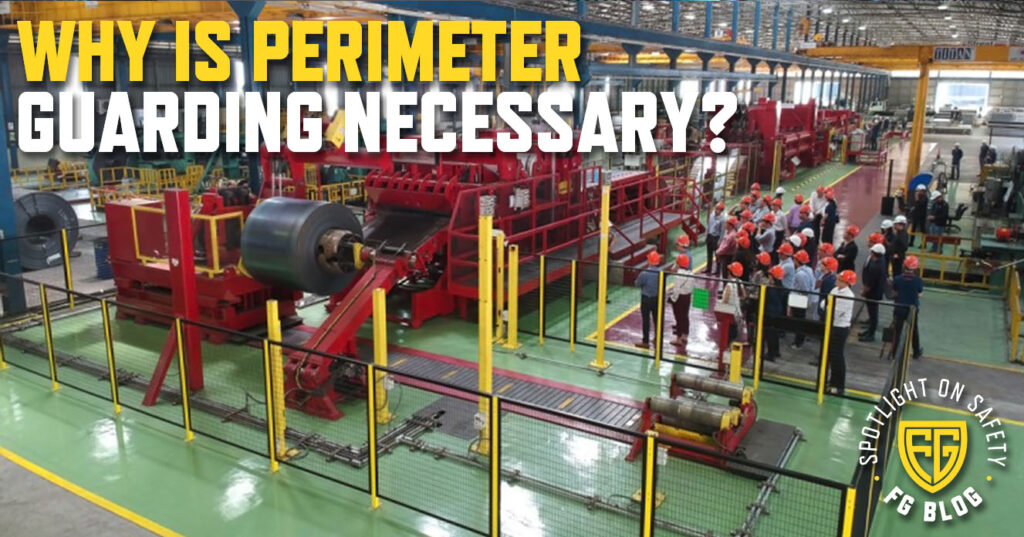Why is Perimeter Guarding Necessary?

Welcome to Spotlight on Safety, where every month we like to explore the topic of safety in a warehouse/manufacturing environment! This month, we’re looking into perimeter guarding and why it’s necessary when maintaining a safe work environment.
But what exactly is perimeter guarding? Perimeter guarding refers to anything that blocks the perimeter of a safety hazard from workers and passers-by. It covers everything from machine guarding to alarm systems to guardrails and handrails.
So, let’s talk about the whys and the whats of perimeter guarding. Why is perimeter security necessary, and what kind of guarding should you install in your facility?
Why should you perimeter guard?
This particular blog series is ultimately about safety, and that’s what perimeter guarding boils down to: a necessity in any warehouse or factory that will help ensure the safety and protection of the employees.
The larger versions of perimeter guarding, like machine guarding, are fairly standard in any warehouse or factory. They act as a physical barrier between machines, especially ones that include robotics and employees on the floor.
Machine guarding is important for several reasons, the primary being that if a machine or robot malfunctions, the fence will stop any rogue parts from breaching the perimeter and potentially injuring anyone. Similarly, if an employee were to trip or fall near the perimeter of a machine, the fence will keep them from entering the machine’s range of motion and prevent potential injuries.
The same fences used for machine guarding, can also double as pedestrian perimeter guards to create walkways throughout the facility. These guard-made walkways can keep pedestrians safe from machinery, as well as forklifts and other potentially hazardous traffic. This is especially necessary if you have side door entrances to your facility, or even break rooms or bathrooms that open onto the factory floor.
By installing a guard around the perimeter of your floor and designating specific walkways, you can prevent employees and visitors from walking directly into ongoing work and potential hazards.
Other types of perimeter guards are necessary especially when there is a temporary hazard, for instance if a new structure is being built and there is a lot of construction or if a loading dock door is open. In these cases, guard rails, handrails, and automatic doors or barriers are all excellent perimeter guards.
Ultimately, the big WHY of perimeter guarding is simple: humans make mistakes, machines malfunction, and putting these safety barriers in place is one thing employers can do to ensure that those mistakes or malfunctions don’t become injuries.
What options do you have for perimeter guarding?
So what kinds of perimeter guarding should you install in your facility? Well, that varies depending on the hazards you’re guarding against. If you have large robotic machinery, standard machine guarding is your best option. The wire mesh of the fence ensures that passers-by and employees can see the machine at all times while still providing a sturdy barrier should any malfunctioning or human error occur.
Folding Guard offers several adaptable wire mesh fencing options that are excellent for machine guarding, blocking the main activity of the floors from pedestrian walkways, and even cordoning off electrical panels.
Our Versa Guard™ is an excellent option if you want to install the guarding close to the hazard, creating more space on your floor.
If you’re looking for a more robust perimeter guarding option, Saf-T-Fence® is an excellent choice.
Along with Saf-T-Fence®, Qwik-Fence® is a versatile and sturdy option for both perimeter and pedestrian walkway guarding.
If you’re protecting against a temporary hazard, like construction, a guard rail or a temporary fence are excellent solutions. Guard rails are also useful for hazardous locations like catwalks, platform edges, or rooftops.
If you have a loading dock, you’ll definitely want to install a perimeter guard across your loading dock doors for those times when a truck is not present but the door is still open. An automatic barrier, like a door or rail that swings open or down when a truck is not present, is your best bet. That way, as soon as the truck leaves, the gate is triggered and dangerous falls are prevented.
Perimeter guards can be used for security as well, with sound alarms that trigger when someone enters a restricted area. Light curtains are another automatic perimeter guard that can be used for security or around machines, automatically sounding off or stopping the machine when a person or object passes through the curtain.
There are numerous potential hazards in any warehouse or factory. Luckily, there are as many perimeter guard options that can be installed to prevent potential injuries, ensuring that the workplace is safe and secure. To learn more about perimeter guards, especially machine guarding, check out our variety of products for security and safety precautions.
